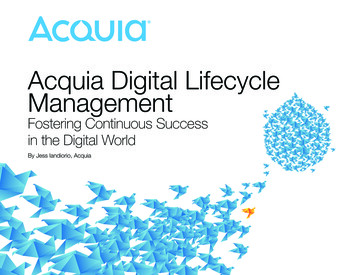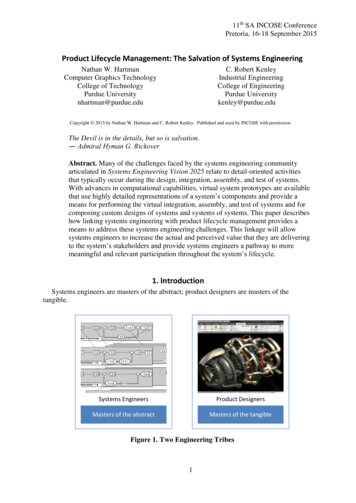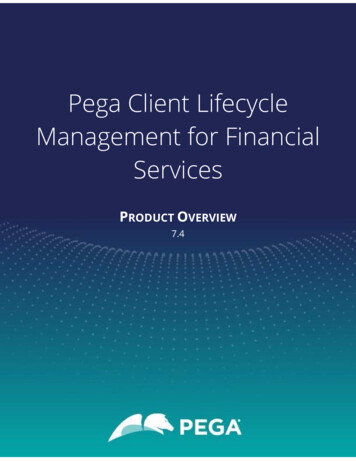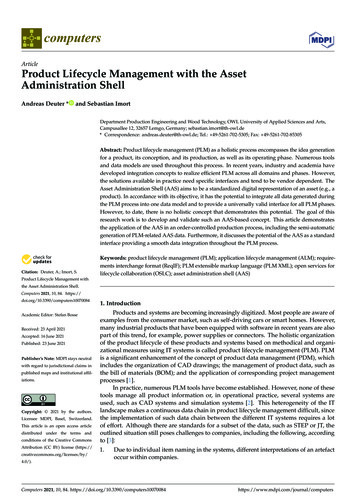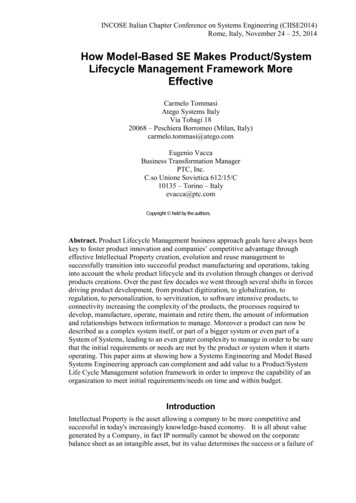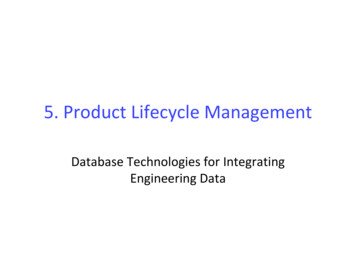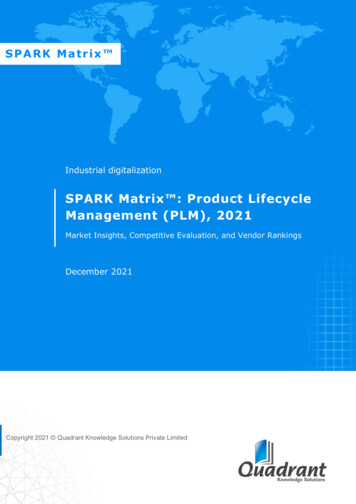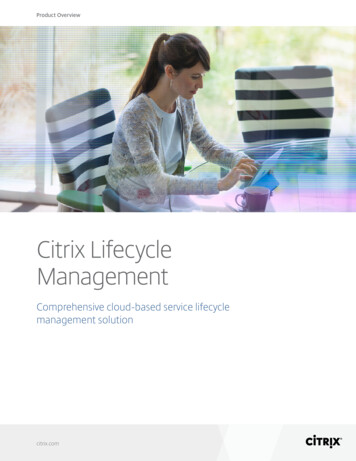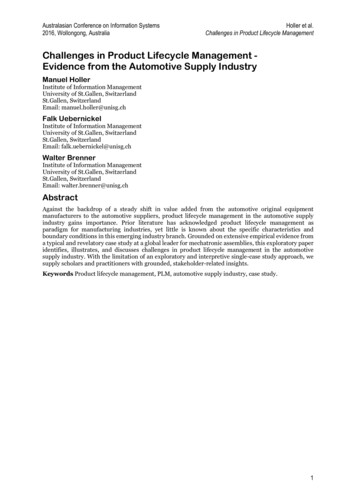
Transcription
Australasian Conference on Information Systems2016, Wollongong, AustraliaHoller et al.Challenges in Product Lifecycle ManagementChallenges in Product Lifecycle Management Evidence from the Automotive Supply IndustryManuel HollerInstitute of Information ManagementUniversity of St.Gallen, SwitzerlandSt.Gallen, SwitzerlandEmail: manuel.holler@unisg.chFalk UebernickelInstitute of Information ManagementUniversity of St.Gallen, SwitzerlandSt.Gallen, SwitzerlandEmail: falk.uebernickel@unisg.chWalter BrennerInstitute of Information ManagementUniversity of St.Gallen, SwitzerlandSt.Gallen, SwitzerlandEmail: walter.brenner@unisg.chAbstractAgainst the backdrop of a steady shift in value added from the automotive original equipmentmanufacturers to the automotive suppliers, product lifecycle management in the automotive supplyindustry gains importance. Prior literature has acknowledged product lifecycle management asparadigm for manufacturing industries, yet little is known about the specific characteristics andboundary conditions in this emerging industry branch. Grounded on extensive empirical evidence froma typical and revelatory case study at a global leader for mechatronic assemblies, this exploratory paperidentifies, illustrates, and discusses challenges in product lifecycle management in the automotivesupply industry. With the limitation of an exploratory and interpretive single-case study approach, wesupply scholars and practitioners with grounded, stakeholder-related insights.Keywords Product lifecycle management, PLM, automotive supply industry, case study.1
Australasian Conference on Information Systems2016, Wollongong, AustraliaHoller et al.Challenges in Product Lifecycle Management1 IntroductionMuch has been written about automotive original equipment manufacturers (OEMs). Having the wellknown “big brands” in mind, the automotive industry is often diminished to those flagship enterprises.A look behind the scenes reveals a not less powerful and absorbing ecosystem: The automotive supplyindustry. Some figures demonstrate the branch’s magnitude: Market research company “Statista”quotes the worldwide revenue outlook for the automotive supply industry to 1,700 billion Euro in 2020,compared to 640 billion Euro in 2001 (Statista 2015). Thereby, a large share of innovation makes itstransition from the OEMs to the suppliers. Over the last decades the worldwide proportion of valueadded by suppliers grew from 56 percent in 1985 to 82 percent in 2015 (Statista 2015). Evermore keytechnologies for the next wave of automotive innovation are developed outside the OEMs’ R&D labswhich focus increasingly on their system and assembly competence (VDA 2012).Within this challenging environment of quality improvement, reduction of cost and time to market, aneffective and efficient management of the suppliers’ products – expressed in other words “productlifecycle management” – seems more timely and relevant than ever. As an established field of researchand practice, a number of conceptualizations for product lifecycle management (PLM) have beensuggested (Saaksvuori and Immonen 2002; Ameri and Dutta 2005; Grieves 2006; Eigner and Stelzer2008; Terzi et al. 2010; Stark 2015), yet the authors understand product lifecycle management as acomprehensive strategy of managing a company’s products all the way across their lifecycles. Within theprofound digitalization in manufacturing industries (Yoo 2010; Fichman et al. 2014), thought leaderspropose novel ideas such as closed-loop product lifecycle management (Kiritsis 2011), digital twinconcepts (Boschert and Rosen 2016), or cloud-based approaches (Lehmhus et al. 2015).Yet, a glimpse at the daily business of manufacturing companies unveils challenges in product lifecyclemanagement at various levels. In this sense, it is crucial to precisely understand the current situation asprerequisite to provide adequate solutions. Although product lifecycle management systems representone of the essential information systems in industrial enterprises, research on product lifecyclemanagement is not a common subject in the domain of information systems (Fichman et al. 2013; Davidand Rowe 2015). Despite some adjacent works, it is not clear which specific challenges automotivesuppliers face. Hence, grounded on extensive empirical evidence from a typical and revelatory case studyat a global leader for mechatronic assemblies, embedded in one of Europe’s largest industrial consortia,we explore these obstacles. For this objective, we word the subsequent research question:[RQ] “What are challenges in product lifecycle management in the automotive supply industry?”The remainder of this paper is arranged in the following way: In chapter two, we introduce fundamentalconcepts and provide an overview on related work. In chapter three, we present the applied case studyresearch methodology with data collection and data analysis. In chapter four, we list and illustrate theidentified challenges and discuss them in chapter five. In a final step, we close with a summary,implications for scholars and practitioners, and research limitations.2 Theoretical Foundations2.1 Product LifecycleExisting literature occupies two main perspectives regarding the lifecycle of industrial products: Thesales-oriented and the engineering-oriented perspective (Sundin 2009; Cao and Folan 2012). The salesoriented view distinguishes the stages market development, market growth, market maturity, andmarket decline (Cao and Folan 2012). In contrast, in the engineering-oriented view an establishedconceptualization of the product lifecycle is the differentiation into beginning-of-life (BOL), middle-oflife (MOL), and end-of-life (EOL) (Cao and Folan 2012). Thereby, BOL encompasses productconceptualization, definition, and realization. MOL comprises product usage, service, and maintenance.EOL may be shaped by various scenarios from refurbishing to disposal (Terzi et al. 2010; Stark 2015).Beside this evenly distributed engineering-oriented view, a more frontloaded conceptualization with thestages requirements elicitation, product planning, development, process planning, production,operations, and recycling is in wide use (Eigner and Stelzer 2008; Eigner and Roubanov 2014).2
Australasian Conference on Information Systems2016, Wollongong, AustraliaHoller et al.Challenges in Product Lifecycle Management2.2 Product Lifecycle Management2.2.1 Development and Conceptualizations of PLMThe evolution of product lifecycle management from its early days to its present form occurred in severalwaves over the last decades (Ameri and Dutta 2005; Cao and Folan 2012). In the 1980s, the first isolatedcomputer-aided technologies with focus on product development such as computer-aided design (CAD)came up. As a result, product data management (PDM) systems were developed to administer thosetechnologies to support the design chain. In parallel, enterprise resource planning (ERP) systems weredesigned to assist the supply chain (Ameri and Dutta 2005). In the 1990s, the concept of PDM evolvedto product lifecycle management (PLM) through horizontal integration (upstream and downstreamprocesses) and vertical integration (customers and suppliers) (Eigner and Stelzer 2008). In the 2000s,empowered by new capabilities of intelligent products, the latest manifestation closed-loop PLM targetsseamless information and knowledge flows through all phases across the product lifecycle (Kiritsis2011). In sum, no common perspective on product lifecycle management exists. An impressive numberof conceptualizations have been suggested, Table 1 provides an overview.ConceptualizationSource“( ) product lifecycle management is a systematic, controlled concept formanaging and developing products and product-related information ( )”Saaksvuori and Immonen (2002, p.3)“( ) product lifecycle management is a business solution which aims tostreamline the flow of information about the product and related processesthroughout the product’s lifecycle such that the right information in the rightcontext at the right time can be made available ( )”Ameri and Dutta (2005, p.577)‘‘( ) product lifecycle management is an integrated, information-drivenapproach comprised of people, processes/practices, and technology to all aspectsof a product’s life, from its design through manufacture, deployment andmaintenance - culminating in the product’s removal from service and finaldisposal ( )”‘‘( ) product lifecycle management encompasses all activities and disciplines thatdescribe the product and its production, operations, and disposal over theproduct lifecycle, engineering disciplines, and supply chain ( )”Grieves (2006, p.39)“( ) product lifecycle management is playing a “holistic” role, bringing togetherproducts, services, activities, processes, people, skills, ICT systems, data,knowledge, techniques, practices, procedures, and standards ( )”Terzi et al. (2010, p.364)“( ) product lifecycle management is the business activity of managing, in themost effective way, a company’s products all the way across their lifecycles ( )”Stark (2015, p.1)Eigner and Stelzer (2008, p.37)Table 1. Selected conceptualizations on product lifecycle management2.2.2 Elements and IT Architecture of PLMIn line with the heterogeneous conceptualizations, a unified perspective what product lifecyclemanagement exactly comprises, does not exist. Following Eigner and Stelzer (2008), five main elementsare included: (1) Product data management (e.g., engineering design structures), (2) productiondevelopment (e.g., manufacturing and assembly processes), (3) customer needs management (e.g.,requirements management), (4) material sourcing (e.g., strategic supplier assessment), and (5)management functions (e.g., support for reporting and decision making). Thereby, engineeringcollaboration (e.g., collaboration tools and integrations) connects the different internal and externalstakeholders. Inherently, product lifecycle management should not be regarded as an “out-of-the-box”tool, but rather as an intelligent combination of different systems (Terzi et al. 2010).From an IT architecture perspective, four layer models are prevalent (Eigner and Stelzer 2008, Eignerand Roubanov 2014). Layer 1 represents the author systems (mechanical computer-aided design (MCAD), electrical/electronic computer-aided design (E/E-CAD), computer-aided engineering (CAE), andcomputer-aided software engineering (CASE)). Layer 2 (team data management (TDM)) acts asadministrative layer which handles data close to the author systems in native data formats. Layer 3 (PLMbackbone) enables the actual engineering functions in neutral data formats. Finally, layer 4 projects theenterprise resource planning (ERP) layer. Recent ideas lean towards a multi-disciplinary repository assmart information collector for both design chain and supply chain with individual applications for eachproduct lifecycle phase (Eigner and Roubanov 2014).3
Australasian Conference on Information Systems2016, Wollongong, AustraliaHoller et al.Challenges in Product Lifecycle Management2.3 Related WorkAs holistic approach, product lifecycle management touches several academic disciplines. Accordingly,related work can be found in various domains. Beside the field of product lifecycle management asestablished research area itself, product development and manufacturing, information systems,management, and computer science literature may be qualified to provide a knowledge base. Adjacentresearch works for the issue at hand include: Burr et al. (2003) explored challenges for computer-aidedtechnologies and engineering data management at an international automotive OEM. Tang and Qian(2008) focused on supplier integration in product lifecycle management targeting automotiveapplications. With his investigation of critical issues and challenges for product lifecycle managementimplementation, Hewett (2010) presented another example. Furthermore, Pulkkinen et al. (2013)addressed the state of the practice and challenges in globally networked manufacturing companies.To summarize: First, product lifecycle management has been investigated rather from conceptual thanfrom empirical points of view. Second, the specific characteristics and boundary conditions of theautomotive supply industry have been disregarded so far. Third, in the domain of information systems,research works on product lifecycle management are underrepresented. In the following, we addressthis research gap with a case study approach.3 Research Methodology3.1 Methodological FoundationsThe objective of this research is to investigate challenges in product lifecycle management with focus onthe automotive supply industry. Despite the availability of similar studies, we selected an exploratoryresearch strategy by three main rationales: First, manufacturing industries are highly specific in nature(Olhager 2003), findings from studies in related industries may not match well. Second, extant studiescommonly regard product lifecycle management as technical system (David and Rowe 2016), and do nottake the manifestation as socio-technical system into account. Third, with product lifecycle managementas inherently information technology-dependent concept, research works from the past may beoutdated. Following the type of the posed research question, the control over behavioral events, and thefocus on a contemporary phenomenon, a case study approach (Benbasat et al. 1987; Eisenhardt 1989;Yin 2009) was chosen. According to Yin (2009, p.13), a case study represents an “empirical inquiry thatinvestigates a contemporary phenomenon within its real-life context, especially when the boundariesbetween phenomenon and context are not clearly evident” which is applicable to our research venture.Following Yin (2009), we selected a single-case study (epistemological perspective: interpretive) whichis an established approach if the case is (1) typical and (2) revelatory.During March 2015 and May 2016, we had the opportunity to gain an intensive insight in a “tier one”automotive supply enterprise (“CarSupply”) developing, manufacturing, and supplying mechanical andmechatronic assemblies for automotive OEMs. In addition to this unique opportunity for access, weconsider this case as typical: First, the investigated case organization exhibits a strong tradition inmechanical engineering, continuously extending its portfolio to mechatronic assemblies. Second,natively characterized by a rather medium size and local footprint, the case organization furthermorefeatures a strong and global expansion. Third, the case organization has implemented an industrystandard four layer IT architecture for product lifecycle management. As qualitative research is oftencriticized (Lincoln and Guba 1989; Klein and Myers 1999; Myers 2013; Sarker et al. 2013), we pursue atransparent and rigorous approach.As case study research strongly relies on the case context (Eisenhardt 1989; Yin 2009), characteristicsof CarSupply are outlined in detail: Ranked among the top three in its market segment, CarSupply aimsto differentiate products by innovation and quality from competitors. For this purpose, CarSupplydevelops products as well as the required production machinery. From a financial viewpoint, CarSupplyfeatures revenues larger than 2,000 million Euro and comprises more than 5,000 employees (2015).The case organization exhibits a global footprint with development and manufacturing locations inEurope, the United States, and Asia. CarSupply is embedded in an interwoven ecosystem, supplyingdozens of OEMs and being supplied by hundreds of suppliers. At a higher level, case organization isembedded in one of Europe’s largest industrial consortia. At a lower level, case organization is organizedin four different operating units. In their daily business, product lifecycle management represents animportant approach to manage their vehicle projects. From an IT perspective, CarSupply operates aPDM/PLM system from a top 5 vendor and an ERP system from a top 3 vendor which are integrated(CIMdata 2016). Thereby, a wide range of integrated tools (mainly requirements management,computer-aided design and simulation tools) serve as author systems.4
Australasian Conference on Information Systems2016, Wollongong, AustraliaHoller et al.Challenges in Product Lifecycle Management3.2 Data CollectionAccording to the principle of triangulation (Yin 2009), multiple sources of evidence and methodologieswere applied for data collection. Yet, semi-structured interviews (Eisenhardt 1989; Yin 2009) built thefoundation. Overall, 21 interviews in three European development and manufacturing locations inrelevant managing, operational, and supporting departments were accomplished on a face-to-face andremote basis. In line with the comprehensive scope of product lifecycle management, we includedconversational partners from all relevant lifecycle stages. Thereby, the sample was compiled in aniterative manner (Lincoln and Guba 1989). In a first step, we interviewed informants with a broadoverview. In the subsequent steps, with the objective to learn more about the discovered issues, weidentified additional, more specialized informants. This “snowball approach” (Lewis-Beck et al. 2004;Patton 2014) was applied until additional data resulted in only minimal new information. For the datacollection, we utilized a questionnaire with open questions designed along recommendations bySchultze and Avital (2011). The questionnaire included sections related to the study purpose,background of the interviewee, strategic, processual, organizational, cultural, and informationtechnology-related aspects of CarSupply’s product lifecycle management, and conclusion. During theresearch process, the questionnaire was iteratively refined. The interviews lasted between 31 and 123minutes with an average of 53 minutes. In order to ensure a rigorous processing, all interviews wererecorded, anonymized, and transcribed. Table 2 provides an overview on accomplished interviews.In addition to the interviews, further sources of evidence (Yin 2009) were considered. Studying archivalrecords (e.g., documentations and management presentations) and artifacts (e.g., software applications)illuminated the issue additionally. All collected data was transferred in a central case study ngdepartmentsInnovation and technology managementHead of innovation and technology managementSales and marketingProcess and quality managementHead of sales and marketingHead of process managementProcess and quality managementProject staff process management (a)Process and quality managementProject staff process management (b)OperationaldepartmentsProduct engineeringProduct engineeringProduct engineeringManufacturing engineeringManufacturing engineeringManufacturing engineeringManufacturing engineeringManufacturing engineeringProcurementLogisticsProductionHead of mechatronics developmentProject engineer engineering designProject engineer simulationHead of manufacturing engineeringHead of technical editingProject lead manufacturing engineeringProject lead equipment procurement (a)Project lead equipment procurement (b)Project staff parts procurementHead of logisticsHead of productionSupportingdepartmentsIT supportIT supportIT supportIT supportIT supportChief information officerGroup head of PLM and CAx projectsHead of IT engineeringHead of PLM application projectsHead of CAx application supportTable 2. Overview on accomplished interviews at CarSupply3.3 Data Analysis and Quality AssessmentFollowing the exploratory character of our research, we adapted grounded theory techniques (Straussand Corbin 1990; Strauss and Corbin 1997) for data analysis. More specifically, the rationale for selectinga grounded theory approach which is well-established is information systems is put forth along threelines (Urquhart and Fernandez 2006; Jones and Noble 2007): First, inductive approaches withoutapplying existing concepts or theories from the body of knowledge are useful for developing insights ifthe phenomenon of interest is novel and data-grounded, unbiased research is desired. Second, groundedtheory approaches generate insights with relevance for both scholars and practitioners, and thuscontribute to reducing the theory-practice gap. Third, grounded theory approaches provide acomprehensive set of techniques without referring to a specific discipline and are able to complementweaknesses of case study research in terms of data analysis.5
Australasian Conference on Information Systems2016, Wollongong, AustraliaHoller et al.Challenges in Product Lifecycle ManagementIn detail, open, axial, and selective coding procedures (Strauss and Corbin 1990; Strauss and Corbin1997) were employed. First, during the initial open coding stage, the transcribed interviews were putinto codes, categories, and subcategories beginning early and iterating during the whole researchprocess. Second, in the subsequent axial coding stage, systematic connections between categories andsubcategories were established. Third, in the final selective coding stage, core categories were selectedand categories and subcategories were rearranged (Strauss and Corbin 1990; Strauss and Corbin 1997).During the coding procedures, computer-assisted qualitative data analysis software (CAQDAS) NVIVO10 was utilized as advised by Alam (2005) and Sinkovics et al. (2005) to assure transparent and efficientdata analysis. Thereby, two theoretically sensitive investigators – guided by the underlying researchquestion und the fundamentals of product lifecycle management, but as open and impartial as possible– constantly compared the emerging codes and categories to harmonize different perspectives and tooccupy a consistent view. Particularly, conceptual maps were used to support the emergence of therelationships in a graphic manner. In total, 513 open codes acted as empirical evidence. For eachidentified challenge in the selective coding stage, the code frequency ranged from 23 to 84 codes.Regarding the quality assessment of grounded theory approaches, Glaser and Strauss (1967) annotatethat (1) grounded theory is a method for building, not verifying and that (2) insights have been verifiedin a certain manner if grounded in data. To ensure quality of our research, we stuck to the guidelines forgrounded theory studies in information systems as suggested by Urquhart et al. (2010). Furthermore,to cope with the interpretive character of our research, we took the concepts credibility, corroboration,and generalizability (Lincoln and Guba 1989; Klein and Myers 1999; Myers 2013) into account.4 ResultsIn the case study, challenges in product lifecycle management in the automotive supply industry wereidentified. Table 3 provides an overview. We seek to present the most impactful aspects with asubsequent in-depth discussion. Accordingly, nine identified challenges are explained in detail andillustrated by the aid of interviewee quotations.No.Challenge#1#2#3#4#5#6#7#8#9Multiple occurrence of media breaks along the lifecycleInsufficient integration of mechanical, E/E, and software developmentComplex data management and collaboration with OEMs and suppliersIsolated engineering change managementHeterogeneous and contrarious requirements for tool portfolioLacking coverage of the complete lifecycleAssurance of data security and protection of intellectual propertyDeficient management and user commitmentMissing link between product lifecycle and knowledge managementTable 3. Challenges in product lifecycle management in the automotive supply industry4.1 Multiple Occurrence of Media Breaks along the LifecycleAs result of the historically grown and distributed system landscapes, automotive suppliers areconfronted with the multiple occurrence of media breaks along the product lifecycle. Product data areexported from system (a) and imported in system (b) which interrupts consistency (“silos”). In earlylifecycle stages, a seamless transition from requirements management to engineering, simulation, andprocess planning rarely exists in current product lifecycle management environments. Furthermore, inlater lifecycle stages, the transition from the design chain (PDM) to the supply chain (ERP) is frequentlyafflicted with media disruptions.“Our current product lifecycle management system is a patchwork rug: We have interfaces to ERP, to a file-based equipment database, to aproject management tool, to a requirements management tool, to computer-aided design applications. Our departments live in a way on“islands of bliss”. The product engineering department is happy, the manufacturing engineering department is happy as well, difficulties alwaysappear at the interfaces.” (Head of mechatronics development)4.2 Insufficient Integration of Mechanical, E/E, and Software DevelopmentWith their traditional mechanics-oriented modus operandi, automotive suppliers face the challenge thatmechanical, electric/electronic, and software development is not integrated sufficiently. Electronics andsoftware have become the new enabler of automotive innovation with high shares of realized productfunctions. Whereas author systems for electrical/electronic design and software engineering wereintroduced and updated over time, management systems were not adapted to the required systemslifecycle management approach for mechatronic products. In this context, model-based engineering, thedescription by models, not by documents, is not widespread across all operational areas.6
Australasian Conference on Information Systems2016, Wollongong, AustraliaHoller et al.Challenges in Product Lifecycle Management“The location for electronics and software development is a great distance off our headquarters where mechanical development is located. Westarted with embedded systems about five years ago and this metaphor represents very well the situation that these streams are often seen astwo worlds. Although some final software versions are integrated in our central PLM application, we generally have separate IT landscapes.”(Head of mechatronics development)4.3 Complex Data Management and Collaboration with OEMs and SuppliersBeing situated in an intermediate position between OEMs and subordinate suppliers, complex datamanagement and collaboration with those stakeholders represent an increasing obstacle for automotivesuppliers. Value chains in the automotive industry become more decentralized and distributed,accordingly data and information exchange at an inter-organizational level gains importance. Despiteconstant efforts on harmonization and standardization between OEMs, tier one, and tier two suppliers,challenges reasoned in different processes and systems are a common issue. Frequently, not the productitself is the bottleneck, but the considerably more complex production machinery to manufacture it.“Parallel to the machine delivery, we get 30 gigabyte of data with 30,000 CAD files from our equipment supplier. A manual integration of thatdata into our current PLM application would costs about two man months. Overall, our installed base encompasses more than 1,000 machines.This fact becomes even more difficult as those machines have a lifecycle with modifications, too. Internally, we call this “Ping Pong” with theequipment supplier.” (Head of technical editing)4.4 Isolated Engineering Change ManagementAlthough development and manufacturing for high-volume quantities is a most widely standardizedprocess, engineering changes with minor and major implications regularly impede automotive suppliersin their daily business. Drawing upon the logic of exponential growth of change and error correctioncosts with every passed through lifecycle stage, engineering change management represents an essentialcomponent of product lifecycle management. Conditioned by high product complexity involvingdifferent engineering disciplines and globally spread stakeholders, assessing, managing, andcommunicating engineering changes constitutes a major obstacle.“Engineering changes are ok, they cannot be avoided, caused by customers, suppliers, or internal necessities. Most of our efforts focus on theoptimization of regular activities, but we do not pay much attention to the handling of unscheduled events. Currently, we have two engineeringchange processes implemented in our PLM system which offer basic functionalities. In my opinion, engineering change management lacks increating transparency and enabling communication.” (Head of manufacturing engineering)4.5 Heterogeneous and Contrarious Requirements for Tool PortfolioFrom a tool perspective, automotive suppliers are challenged by boundary conditions such as workingprinciples and software standards. On the one hand, working with dozens of OEMs imposing differentrequirements results in a redundant system landscape. On the other hand, also strategically importantsupplier monopolists raise similar requirements. Finally, the IT strategy department of the affiliatedgroup pursues enhancements in terms of harmonization and simplification of the tool portfolio in theirbusiness areas and business units. Although every stakeholder has its rationale, in sum heterogeneousand contrarious requirements for the automotive suppliers’ tool portfolio result.“Currently, the IT engineering department administrates seven different CAD tools (“the tool zoo”). In my opinion, a large share of daily CADtasks can be attended with one standardized application. One challenge is especially “the company in the company” which has its own specialties.Beyond our subsidiary, in our automotive business area [company1] has [tool1], [company2] has [tool2], and so forth. Although manydiscussions are ongoing, almost no synergies are leveraged.” (Group head of PLM and CAx projects)4.6 Lacking Coverage of the Complete LifecycleOther than indicated by the notion, existing product lifecycle management approaches in the automotivesupply indus
2016, Wollongong, Australia Challenges in Product Lifecycle Management 4 2.3 Related Work As holistic approach, product lifecycle management touches several academic disciplines. Accordingly, related work can be found in various domains. Beside the field of product lifecycle management as
